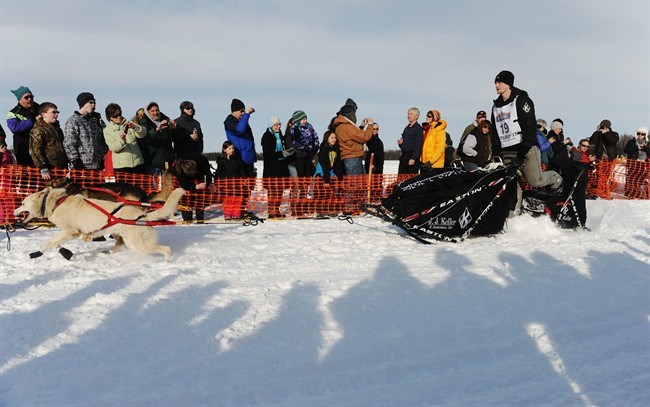ANCHORAGE, Alaska - Here's one proven way to win the Iditarod Trail Sled Dog Race: Let others take the early lead in the 1,000-mile (1610-kilometre) trek to Alaska's wind-scoured western coast.
That approach might seem counterintuitive to the novice fan of the famous sled dog race. Running the Iditarod is as simple and straightforward as hitching 16 dogs in front of a sled and bolting off into the snowy horizon, right?
Uh, no. Just ask some top mushers. Lagging behind to let dogs conserve their energy is among strategies employed by top mushers. But holding back can also backfire for various reasons, if the timing is miscalculated, for example, or a fierce blizzard strikes at the wrong time.
Four-time champion Martin Buser had the early lead Monday, pulling into the scenic Rainy Pass checkpoint at 5:38 a.m., spending just two minutes there before getting back on the trail.
He was followed by another musher with impressive Iditarod credentials — four-time champion Lance Mackey. He pulled into the Finger Lake checkpoint on Sunday night, also spending just a couple minutes resting before heading out again.
For defending champion Dallas Seavey, patience and an unwavering trust in the capability of his team paid off last year, when he became the Iditarod's youngest winner ever at age 25. He didn't charge to the front until later in the race, but still reached the finish line in Nome an hour before his closest competitor. To rest some of his older veteran dogs more, Seavey sometimes carried them in his sled for long stretches.
"It takes an uncommon amount of confidence in your dog team to watch those front-runners get away from you," said Seavey, who turned 26 Monday.
Rushing on, however, can exhaust a team to the point of losing. Two Rivers musher Allen Moore, who is running the Iditarod, just won the 1,000-mile Yukon Quest International Sled Dog Race in February by choosing to rest his dogs. His main rival, last year's Quest winner Hugh Neff, chose to run.
"He gambled that he could go," Moore said. "I was gambling that this rest would help me to be faster. It's like this in the Iditarod, too. We're just gambling on things we think will work."
And then there's the winning strategy of deception, as employed in 2008 by Mackey.
Mackey and four-time Iditarod Jeff King were running neck and neck, prompting Mackey to pull off a stunt at the Elim checkpoint — 123 miles (199 kilometres) from the Nome finish line. Mackey had arrived at the checkpoint three minutes ahead King and made a big show of settling in for a nap. King's team settled in, too.
But Mackey had told checkpoint volunteers to wake him in an hour. He sneaked out of the checkpoint 70 minutes ahead King and won the race.
___
Follow Rachel D'Oro on Twitter at https://twitter.com/rdoro



